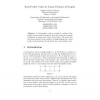55 search results - page 2 / 11 » Cancellation properties of products of graphs |
CORR
2006
Springer
13 years 5 months ago
2006
Springer
It is known that the expansion property of a graph influences the performance of the corresponding code when decoded using iterative algorithms. Certain graph products may be used ...
ISPAN
2008
IEEE
13 years 11 months ago
2008
IEEE
Intuitively, a signed graph is a graph in which every edge is labeled with a + or − sign. For each edge, its sign represents the mode of the relationship between the vertices it...
ARSCOM
2008
13 years 4 months ago
2008
A total perfect code in a graph is a subset of the graph's vertices with the property that each vertex in the graph is adjacent to exactly one vertex in the subset. We prove t...
WAW
2007
Springer
13 years 11 months ago
2007
Springer
Inspired by the recent interest in combining geometry with random graph models, we explore in this paper two generalizations of the random dot product graph model proposed by Kraet...
CORR
2010
Springer
13 years 5 months ago
2010
Springer
The oriented chromatic number of an oriented graph G is the minimum order of an oriented graph H such that G admits a homomorphism to H. The oriented chromatic number of an undire...

